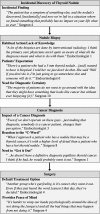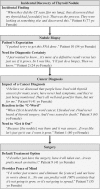From Overdiagnosis to Overtreatment of Low-Risk Thyroid Cancer: A Thematic Analysis of Attitudes and Beliefs of Endocrinologists, Surgeons, and Patients
- PMID: 31910092
- PMCID: PMC7232663
- DOI: 10.1089/thy.2019.0587
From Overdiagnosis to Overtreatment of Low-Risk Thyroid Cancer: A Thematic Analysis of Attitudes and Beliefs of Endocrinologists, Surgeons, and Patients
Abstract
Introduction: The optimal management for patients with small, low-risk thyroid cancer is often debated. We aimed to characterize the attitudes and beliefs of providers and patients about management of small, low-risk thyroid cancer and how they relate to overtreatment. Methods: We conducted 34 semi-structured interviews with surgeons (n = 12), endocrinologists (n = 12), and patients with <1.5 cm papillary thyroid cancer (n = 10). Interviews probed about diagnosis and treatment decision-making, including nonoperative options. We used thematic analysis to identify themes related to overtreatment and created concept diagrams to map observed relationships between themes. Results: When providers discussed management of small, low-risk thyroid cancer, most felt that overtreatment was a problem, and some brought it up without prompting. Providers often believed that overtreatment results from overdiagnosis and relayed how the process commonly starts with incidental discovery of a thyroid nodule on imaging. Providers viewed biopsy of the nodule as a reflexive or habitual action. They ascribed inappropriate biopsy to lack of adherence to or knowledge of guidelines, radiologist recommendations, and the desire of patients and physicians to minimize diagnostic uncertainty. Providers described subsequent cancer diagnosis as an event that "opens Pandora's box" and often provokes a strong instinctive, culturally rooted need to proceed with surgery-specifically total thyroidectomy. Consequently, most providers felt that it is easier to prevent overdiagnosis than overtreatment and recommended strategies such as improving guideline adherence, resetting patients' expectations, and engaging the media. In contrast, patients did not bring up or openly discuss overtreatment or overdiagnosis. Some patients described the seemingly automatic process from an incidental finding to surgery. Their statements confirmed that the "need to know" was a major motivation for biopsying their nodule. Patients felt that once they had a cancer diagnosis, surgery was a foregone conclusion. Patients admitted their knowledge about thyroid nodules and cancer was low, leaving room for education about the need for biopsy and less extensive treatment options. Conclusions: Surgeons' and endocrinologists' attitudes and beliefs about overtreatment focus on the automaticity of overdiagnosis. Both patients and providers are cognizant of the cascade of clinical events that propel patients from incidental discovery of a thyroid nodule to surgery.
Keywords: low-risk; overdiagnosis; overtreatment; qualitative; thyroid cancer.
Conflict of interest statement
No competing financial interests exist.
Figures
References
-
- Davies L, Morris LG, Haymart M, Chen AY, Goldenberg D, Morris J, Ogilvie JB, Terris DJ, Netterville J, Wong RJ, Randolph G; AACE Endocrine Surgery Scientific Committee. 2015. American Association of Clinical Endocrinologists and American College of Endocrinology Disease state clinical review: the increasing incidence of thyroid cancer. Endocr Pract 21:686–696 - PMC - PubMed
-
- Davies L, Welch HG. 2014. Current thyroid cancer trends in the United States. JAMA Otolaryngol Head Neck Surg 140:317–322 - PubMed
-
- Davies L, Welch HG. 2006. Increasing incidence of thyroid cancer in the United States, 1973–2006. JAMA 295:2164–2167 - PubMed
-
- SEER cancer statistics factsheets: thyroid cancer. National Cancer Institute, Bethesda, MD. Available at http://seer.cancer.gov/statfacts/html/thyro.html (accessed June4, 2019)
-
- Welch GH. 2017. Cancer screening, overdiagnosis, and regulatory capture. JAMA Intern Med 177:915–916 - PubMed
Publication types
MeSH terms
Grants and funding
LinkOut - more resources
Full Text Sources
Medical



